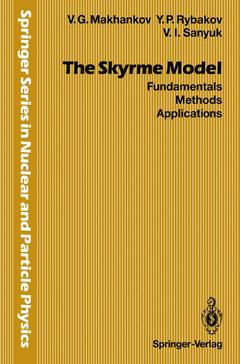Description
The Skyrme Model, Softcover reprint of the original 1st ed. 1993
Fundamentals Methods Applications
Springer Series in Nuclear and Particle Physics Series
Authors: Makhankov Vladimir G., Rybakov Yurii P., Sanyuk Valerii I.
Language: English
105.49 €
In Print (Delivery period: 15 days).
Add to cart
Publication date: 02-2012
265 p. · 15.5x23.5 cm · Paperback
265 p. · 15.5x23.5 cm · Paperback
Description
/li>Contents
/li>
The December 1988 issue of the International Journal of Modern Physics A is dedicated to the memory of Tony Hilton Royle Skyrme. It contains an informative account of his life by Dalitz and Aitchison's reconstruction of a talk by Skyrme on the origin of the Skyrme model. From these pages, we learn that Tony Skyrme was born in England in December 1922. He grew up in that country during a period of increasing economic and political turbulence in Europe and elsewhere. In 1943, after Cambridge, he joined the British war effort in making the atomic bomb. He was associated with military projects throughout the war years and began his career as an academic theoretical physicist only in 1946. During 1946-61, he was associated with Cambridge, Birmingham and Harwell and was engaged in wide-ranging investigations in nuclear physics. It was this research which eventually culminated in his studies of nonlinear field theories and his remarkable proposals for the description of the nucleon as a chiral soliton. In his talk, Skyrme described the reasons behind his extraordinary sug gestions, which when first made must have seemed bizarre. According to him, ideas of this sort go back many decades and occur in the work of Sir William Thomson, who later became Lord Kelvin. Skyrme had heard of Kelvin in his youth.
I Fundamentals.- 1. The Evolution of Skyrme’s Approach.- 1.1 The “Mesonic Fluid” Model.- 1.2 The Chiral Modification.- 1.3 The Two-Dimensional Simplified (sine-Gordon) Model.- 1.3.1 The Idea of Topological Charge.- 1.3.2 The Abelian Bosonization or Fermi-Bose Correspondence.- 1.4 The Baryon Model — Topological Skyrmions.- 1.4.1 The (3+1)-dimensional “Angular” Variables.- 1.4.2 The Topological Charge in the (3+1) Model.- 1.4.3. The Skyrme Model Dynamics.- 1.5 Skyrme’s Results and Conjectures.- 2. Elements of Field Theory with Topological Charges.- 2.1 Geometric Viewpoint on the Classical Field Theory.- 2.1.1 The Configuration Space.- 2.1.2 Homotopy as a Formalization of Dynamical Evolution.- 2.2 The Topological Classification of Solutions.- 2.2.1 Homotopy Classes of the sine-Gordon Model.- 2.2.2 The Fundamental and Higher Homotopy Groups.- 2.3 Isham’s Construction of Topological Charges.- 2.3.1 Cohomology — Homotopy Relationship in Brief.- 2.3.2 Derivation of Topological Charge in the Skyrme Model.- 2.4 Guiding Principles in the Choice of Model Lagrangians.- 2.4.1 Chirally Invariant Lagrangians.- 3. Topological Stability.- 3.1 Some General Remarks.- 3.2 The Hobart-Derrick Theorem.- 3.3 Soliton Stability and the Second Variation Structure of the Lyapunov Functional.- 3.3.1 The Lyapunov Stability of Solitons.- 3.3.2 The Generalized Hobart-Derrick Theorem.- 3.3.3 The Q-stability of Solitons.- 3.4 The Topological Stability of Skyrmions.- II Methods for the Study of Skyrmions.- 4. The Principle of Symmetric Criticality.- 4.1 Some Auxiliary Information.- 4.2 The Symmetry Group of the Skyrme Energy Functional.- 4.3 The Coleman-Palais Theorem.- 4.4 The Structure of Invariant Fields (Ansätze).- 5. Absolute Minimum of the Energy Functional.- 5.1 Method of Extending the Phase Space.- 5.2 The Spherical Rearrangement Method.- 5.3 Skyrmion as the Absolute Minimizer of the Energy.- 6. The Existence of Skyrmions.- 6.1 The Field Equations for Skyrmions.- 6.2 The Direct Method in the Calculus of Variations.- 6.3 An Outline of the Proof of the Skyrmion Existence.- 7. Multi-Baryon and Rotating Skyrmion States.- 7.1 The Problem of Bound States and Interaction Among Skyrmions.- 7.1.1 The Invariant Fields in Higher Homotopy Classes.- 7.2 Minima of the Energy Functional in Higher Homotopy Classes.- 7.3 The Rotating Skyrmion.- 8. Quantization of Skyrmions.- 8.1 Bogolubov’s Method of Collective Coordinates.- 8.2 Canonical Quantization of Skyrmions.- 8.3 The “Non-Rigid” Quantization of Skyrmions.- III Hadron Physics Applications.- 9. The Skyrme Model and QCD.- 9.1 Express Review of the QCD Present Status.- 9.2 1/N-Expansion.- 9.3 Effective Meson Theory from QCD.- 9.3.1 The Low-energy QCD Attributes.- 9.3.2 The Topological Charge as the Baryon Number.- 9.3.3 Effective Chiral Lagrangians from QCD.- 10. Skyrmion as a Fermion.- 10.1 The Finkelstein’s Double-Valued Functionals.- 10.2 The Charge-Monopole Multi-valued Action.- 10.3 The Wess-Zumino Term and Witten’s Realization of Skyrme’s Suggestion.- 10.3.1 The Wess-Zumino Term in Effective Chiral Lagrangian.- 10.3.2 Spin and Statistics of Skyrmions.- 11. Quantized SU(3) Skyrmions and Their Interactions.- 11.1 The SU(Z) Generalized Lagrangian in Terms of Collective Coordinates.- 11.1.1 The SU(3) Skyrme “Collective” Lagrangian.- 11.1.2 The Wess-Zumino Term for Collective Coordinates.- 11.1.3 The Symmetry Breaking Term.- 11.2 Quantization in the Presence of the Wess-Zumino Term.- 11.2.1 Canonical Quantization.- 11.2.2 Symmetries, Constraint and Spectrum.- 11.2.3 Static Observables and Mass Formulae.- 11.3 Skyrmions’ Interactions: Nuclear Forces and Nuclear Matter.- 11.3.1 The Skyrmion-Skyrmion Interaction and Nuclear Forces.- 11.3.2 The Meson-Baryon Interaction.- 11.3.3 The Skyrme Model and Nuclear Matter.- Concluding Remarks.- IV Appendices.- A. Chiral Symmetry.- A.1 Algebraic Aspects of Chiral Symmetry.- A.2 Geometric Aspects of Chiral Symmetry.- B. A Concise Account of Algebraic Topology.- B.1 Smooth Manifolds.- B.2 Tangent Spaces, Vector Fields and Lie Algebras.- B.3 Differential Forms.- B.4 Integration on Manifolds and De Rham Co-Homologies.- B.5 Fundamental Groups, Homotopy Groups and Some Other Topological Invariants.- C. Methods of Reduction.- C.1 Reduction to Static Field Configurations.- C.2 Reduction to G-Invariant Fields.- C.3 Spherical Rearrangement Technique: An Illustration.- D. Proofs of Stability and Existence Theorems.- D.1 Proof of Generalized Hobart-Derrick Theorem.- D.2 Existence of the Axially-Symmetric Solutions.- D.3 Existence of a Nonsingular Matrix.- E. Finkelstein-Williams’ Spinor Structures.- References.
© 2024 LAVOISIER S.A.S.
These books may interest you

Advances in Nuclear PhysicsVolume 22 105.49 €



